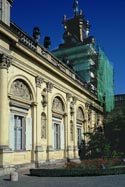1999 Photographs from Warsaw | Panoramic Photographs 1 2 3 4 5 | 1997 Photographs and Text from Warsaw | Poland Site Index | Home
My flight arrived about 30 minutes early in Warsaw, giving me some time to watch the groups of people returning home to Poland. At the exit doors from the customs area, a huge crowd forms and it's not unusual to see several generations of the family waiting in anticipation for relatives and friends to return. If the arriving traveler is a woman, she is usually given a bouquet of flowers. This is often only a few cut stems though I did see some bouquets almost too large to carry. One group seemed to be meeting a new family member for the first time, probably a new husband or fiancé. Their reception included a large bouquet accompanied by a round loaf of bread nearly 24" in diameter. The bouquet was placed on top of the luggage, the bread was held out in front and everyone posed for several photographs.
Marek Baranski arrived right on time. We met during my first visit to Poland while he spent several days with our APT delegation, guiding us through numerous sites at all of the cities we visited in 1997. Marek is highly active within the Polish preservation field as director of an building restoration office, PKZ Zamek. Mr. Baranski took me to my hotel and suggested that I visit Wilanow and Lazienki, especially since the weather was so sunny and warm. He offered to take me there and gave me directions for returning to the center of the city by bus. As we drove through the city, I noticed a change in the skyline of Warsaw since my last visit in 1997: several new 20+ story buildings are now on the skyline.

 Wilanow was built as the summer
residence for Jan III Sobieski in the late 1600s and passed to
subsequent Polish royalty. The main building has been under a
long period of restoration in recent decades and grounds of the
complex has very nice gardens. Even in early October, many of
the flowers were still in bloom. The building's interior consists
of restored period rooms and almost every one is open to the
public for viewing. The floor surfaces of each room were one
of the most interesting attributes of the individual spaces.
Every room's floor uses a different material and/or pattern to
mark each space as a distinct area, a composition of its own.
An Escher-like pattern is located in a room just off the main
entrance. Three-dimensional cubes pile one atop the other in
a pattern that can be viewed from multiple angles with the same
stacked effect. It is a striking pattern. The shapes of each
tile unit do not vary from piece to piece. At various times throughout
the rest of the day I found myself wondering how a similar pattern
could be cut from modern sheet material and mass-produced.
Wilanow was built as the summer
residence for Jan III Sobieski in the late 1600s and passed to
subsequent Polish royalty. The main building has been under a
long period of restoration in recent decades and grounds of the
complex has very nice gardens. Even in early October, many of
the flowers were still in bloom. The building's interior consists
of restored period rooms and almost every one is open to the
public for viewing. The floor surfaces of each room were one
of the most interesting attributes of the individual spaces.
Every room's floor uses a different material and/or pattern to
mark each space as a distinct area, a composition of its own.
An Escher-like pattern is located in a room just off the main
entrance. Three-dimensional cubes pile one atop the other in
a pattern that can be viewed from multiple angles with the same
stacked effect. It is a striking pattern. The shapes of each
tile unit do not vary from piece to piece. At various times throughout
the rest of the day I found myself wondering how a similar pattern
could be cut from modern sheet material and mass-produced.
From Wilnow, I took the bus to Lazienki, a park located not too far from central Warsaw. Thousands of people and families were strolling the paths of this large site. I suspected that the Poles take their walking in a serious and whole-hearted manner because few benches are available. Seating areas are only clustered near the main monuments and buildings. The organization of the paths is formal. Long straight axis connect the primary focal point of the park with smaller diagonal axes crossing occasionally between the main paths. Winding paths are used only where steep or unusual topography requires it. Though the paths are formal, the materials are informal. Loose gravel without edging is used to delineate walking routes. Trees and other vegetation are allowed to grow normally without excessive pruning or trimming.
After about an hour walking the park, I was more appreciative of Frederick Law Olmstead's designs for Central Park in Manhattan and Prospect Park in Brooklyn. These natural areas in Wilanow and Lazienki have a distinct design hierarchy to distinguish the man-made and the natural. For Olmstead, the distinction between natural and man-made is much less apparent; his designs feel like being enveloped in perfect natural growth even though every stone, tree and patch of grass has been carefully choreographed.
By this time it was
about 4pm in Warsaw, 10am by own internal clock which was still
on New York time. I felt as if I had been awake all night. However,
I gathered enough energy to head back into central Warsaw to
have a look at the Stare Miasto, Pilsudskiego Square and a few
other areas. The open space in front of the castle was filled
with people, drawn by a festival with food and music. The large
empty space of Pilsudskiego Square was perfect for rollerblades.

|